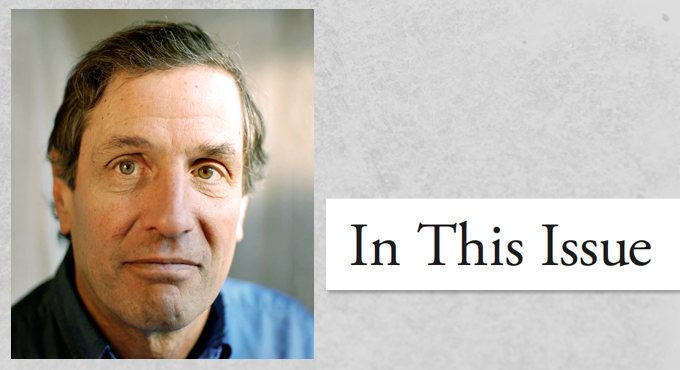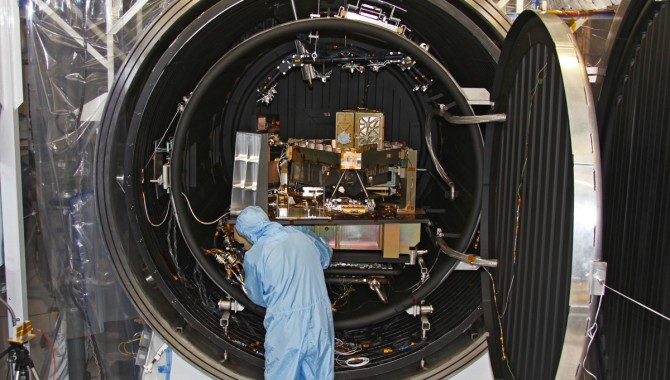
By Karl Saad
Along with a half dozen NASA centers, the European Space Agency (ESA), and a variety of academic and industry partners, the Canadian Space Agency has been working on its contribution to the James Webb Space Telescope.
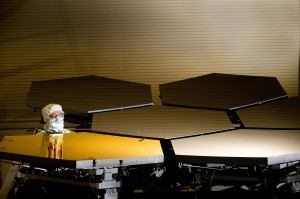
Ball Aerospace optical technician Scott Murray inspects the first gold primary mirror segment, a critical element of NASA’s James Webb Space Telescope, prior to cryogenic testing.
Photo Credit: NASA/Marshall Space Flight Center/David Higginbotham
JWST, as it is commonly known, is a large infrared telescope that will make observations from almost a million miles from Earth after its launch near the end of the decade. With a light-collecting area about seven times that of the Hubble telescope and its sensitivity to infrared wavelengths, JWST will be able to see the most distant (and earliest) galaxies in the universe. It should also provide new insight into the birth of stars and the nature of planets outside our solar system.
Canada is providing two essential instruments. The fine-guidance sensor (or FGS) helps JWST point precisely at its targets and maintain that orientation over the time needed to gather enough light for high-quality images. The near-infrared imager and slitless spectrograph (NIRISS) has several important science objectives: detecting “first light” (the light of the first stars formed in the universe) and finding and characterizing exoplanets.
The Challenges
We have faced plenty of technical challenges designing and building these new instruments. The most challenging aspect of the FGS is the need to achieve the required pointing accuracy while surviving cryogenic temperatures (around -240°C). The FGS will measure the position of guide stars with an accuracy of one millionth of a degree (3.5 milli-arcseconds). The harshness of the environment requires precise considerations of the thermal effects on materials to ensure proper alignment of all optical elements from ambient to cryogenic temperatures. NIRISS replaces what was originally called the tunable filter imager (TFI), because unsolved technical difficulties with a TFI subcomponent threatened the project’s capability to meet its scheduled delivery to NASA.
I believe it is important for people to understand the context of their work at the programmatic level.
As is often true of complex projects, the organizational challenges of communication and cooperation are at least as daunting and important as the technical ones. For instance, the decision to replace the TFI with NIRISS during Phase D of the program—the development phase—was necessarily the product of close collaboration among the interested parties. It could not have happened without the mutual trust and understanding of good working relationships.
Joining the Program
I became project manager for these instruments when the project was already well under way. Phase B preliminary design work had been completed, and we were well into Phase C design, preparing for our critical design review. So a lot was set, but there were still many issues to deal with.
I had previously worked on Herschel, the ESA infrared space telescope launched in 2009. For the Herschel mission, the Canadian Space Agency (CSA) partnered with the Netherlands Institute for Space Research (SRON) for our contribution to the heterodyne instrument in the far infrared (HIFI), one of three science instruments on board Herschel. Working on this project, I gained some experience with issues and technologies relevant to JWST and was exposed to all the facets and challenges of managing a project in an international context. Prior to being assigned to JWST, I had some high-level knowledge of the project from monthly project reviews. But I knew that my first task would be to learn from the team, to keep my eyes and ears open and absorb what was going on rather than try to impose my own ideas on the project. You have to respect and depend on the team.
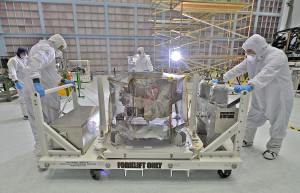
The fine-guidance sensor engineering test unit arrives at Goddard on September 8, 2010.
Photo Credit: Canadian Space Agency
I was fortunate to have a deputy project manager, Luminita Ilinca Ignat, who had been on the project for several years. She ensured a good transition from the old project manager. Along with providing valuable project knowledge, Luminita helped me focus on priorities while giving me time to understand the project and its challenges. Without her as my right-hand person, taking on such a complex project would have been a hair-raising experience, with a real risk of my dropping the ball on important issues.
Deputy project managers work outside the spotlight and most often do not get the praise they deserve for their vital contribution to complex projects. The deputy project manager and project manager form a team within the project team. The relationship between them is critical for creating team cohesion and project success. The challenges of working with a deputy project manager cannot be overlooked either. They are likely to have similar interests and needs with respect to their responsibilities and growth, so it is important to establish clear roles and responsibilities agreed to by both. Most importantly, one must assess when the role of deputy project manager is no longer required on a project and to allow this person to continue to grow professionally and apply the experience and knowledge gained to another project as a project manager. It is all too easy to lose sight of this while managing a complex project.
Our aim is to produce technology, but a project manager deals with people, not machines. You have to get to know them and learn their points of view. You have to let them know that you trust and respect them and believe they have important contributions to make. The project manager needs to bring the team together to work like a well-trained orchestra.

The fine-guidance sensor ready for environmental testing.
Photo Credit: John Brebner, Communications Research Centre
So good communication is essential. We have regular weekly team meetings that include engineers, scientists, and principal investigators—typically a dozen people in the room and another eight or ten calling in. These meetings are very much two-way or multidirectional conversations, with participants hearing from each other.
I believe it is important for people to understand the context of their work at the programmatic level. The JWST project has been in the news recently as a result of the discussions associated with the U.S. government’s appropriation process. This process is not easy for foreigners to follow, and the uncertainty of the project’s future reported by the media, in light of concerns about cost increase and schedule slip, had the potential to affect our team’s focus on the task at hand. The weekly meeting in this case helped the overall team understand the situation. Team members were kept up to date on developments on this front and assured that our project and its tasks were not directly affected. This was good for morale. This was happening at the same time as we were embarking on NIRISS. It was important for the team not to be distracted by events in the United States over which we had no control.
Working with NASA
Before my first visit to the Goddard Space Flight Center, I did not fully understand where we fit in the large, complex JWST program. I needed to know what technical and interface issues still needed to be resolved. And I felt somewhat daunted, a bit like a little kid with his big brother. I worried, too, about the possibility that our relatively small CSA team could be flooded and distracted by constant queries from the much larger contingent of NASA engineers.
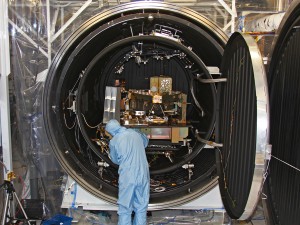
A technician prepares the Canadian-built fine-guidance sensor’s engineering test unit for cryogenic testing at the Canadian Space Agency’s David Florida Lab in Ottawa.
Photo Credit: Canadian Space Agency
That first visit—for a technical interchange meeting—was reassuring. People at Goddard welcomed me as a colleague, not a junior partner. NASA instrument systems engineer Jim Abell and instrument systems manager Scott Lambros, who served as the primary NASA-CSA contacts, functioned as access control points for information from JWST to the Canadian team and vice versa, making sure that the Canadian team would not be overwhelmed by NASA while keeping us fully informed on the development of technical interfaces, and enabling prompt coordination of resources to address technical issues efficiently. They came to Canada for quarterly reviews and attended technical meetings. Jim and Scott helped us make the contacts necessary to do our work, telling us which NASA people we needed to work with and helping to get them together with the appropriate CSA and prime contractor team members. More importantly, they were always able to put the technical issues being flowed down to the FGS project in perspective. We were able to understand the dynamics of JWST issues in relation to the FGS and were therefore able to communicate our concerns with specific issues and potential solutions back to the NASA team.
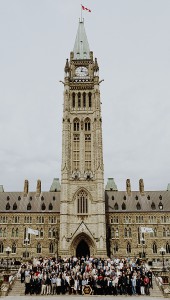
The international James Webb Space Telescope team in front of the Parliament of Canada building in Ottawa. The photo was taken when all partners met in May 2009 for a technical and scientific workshop.
Photo Credit: Canadian Space Agency
Scott and Jim have been critical to ensuring good and timely communication between the FGS team and NASA’s team. They have shown how important the “soft” interfaces are to international collaboration. Creating the personal bonds that go beyond “business” has been critical for us to see our instruments evolve successfully within the complex system of JWST. Scott and Jim’s soft approach and dedication to the JWST project and to our instruments has made them an integral part of the Canadian team, not perceived as outsiders with the sole task of overseeing us.
I worried, too, about the possibility that our relatively small CSA team could be flooded and distracted by constant queries from the much larger contingent of NASA engineers.
Communication between CSA and NASA has included a weekly one-hour teleconference to deal with management issues (plus three or four one-on-one phone calls), a weekly systems engineering telecon, and a weekly flight software telecon. On a biweekly basis, we hold reviews of action items raised at our various meetings and reviews. We attended a JWST project workshop held twice a year until recently and have one or two technical interchange meetings in Canada or at Goddard per year. At the management level, the JWST project manager has held monthly management council meetings involving all partners and industry prime contractors. This level of communication is critical to maintain the interface, to adjust to the dynamics of this interface, and to maintain an overview of the program in such a complex project.
As I write this, our challenge is to get the instrument together, tested, and ready for delivery to NASA. We are scheduled to deliver our protoflight instruments in the late summer of 2012. If all goes well, our success will be due to the technical skills of the team and to the openness, transparency, and constant communication that have characterized our work.
About the Author
 |
Karl Saad has been at the Canadian Space Agency since 2001 working as a project manager. He has worked on projects involving the Netherlands, European Space Agency, and Jet Propulsion Laboratory. Since 2007, he has been the project manager for Canadas contribution to NASAs James Webb Space Telescope. |







